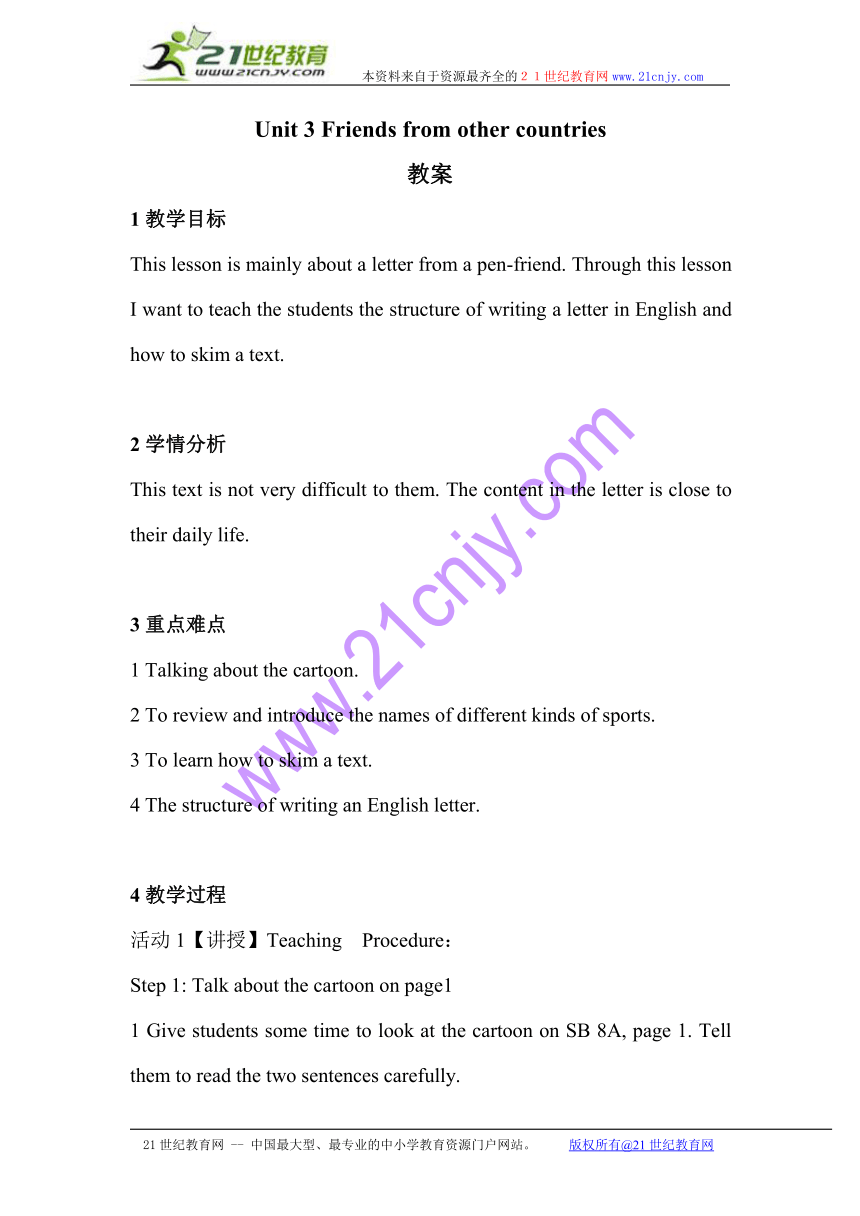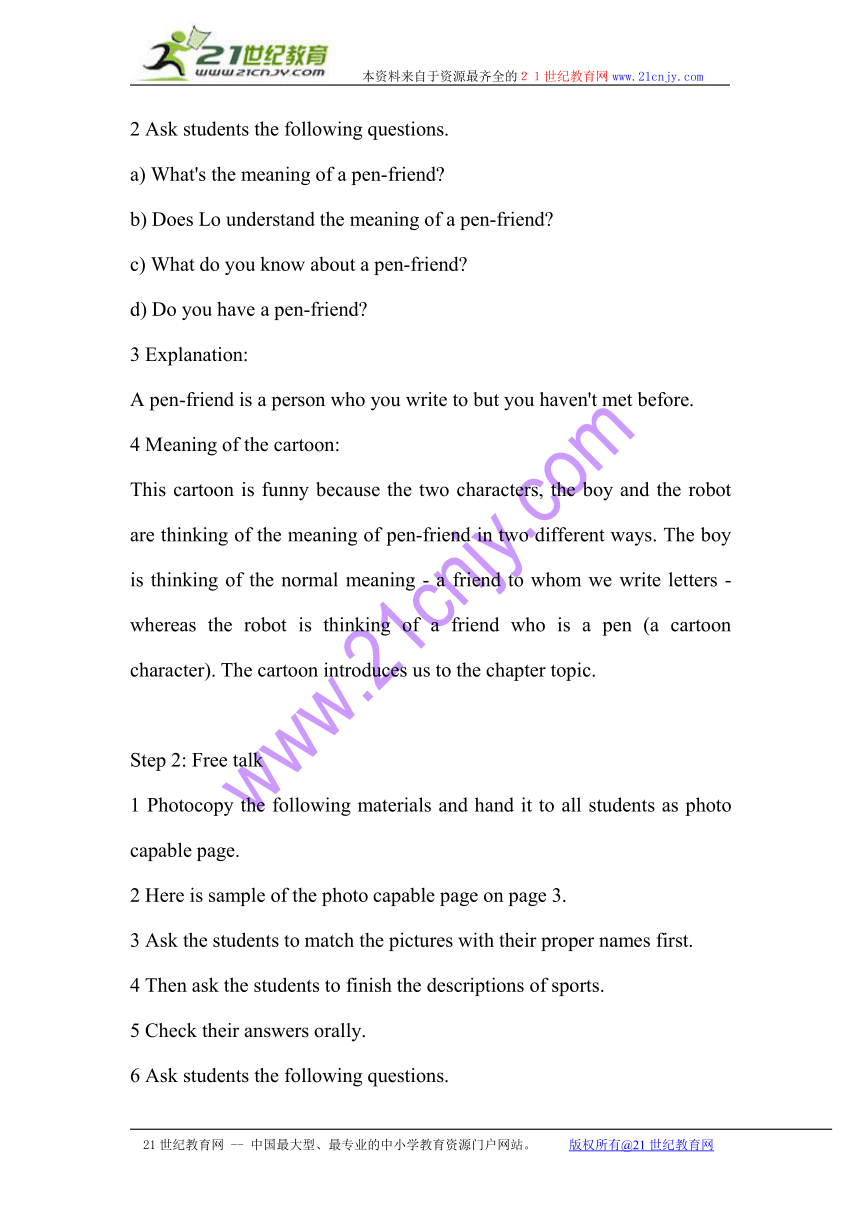Module 1 Relationships Unit 3 Friends from other countries 教案
文档属性
| 名称 | Module 1 Relationships Unit 3 Friends from other countries 教案 |

|
|
| 格式 | zip | ||
| 文件大小 | 11.4KB | ||
| 资源类型 | 教案 | ||
| 版本资源 | 牛津上海版(试用本) | ||
| 科目 | 英语 | ||
| 更新时间 | 2016-11-18 23:39:26 | ||
图片预览


文档简介
本资料来自于资源最齐全的21世纪教育网www.21cnjy.com
Unit
3
Friends
from
other
countries
教案
1教学目标
This
lesson
is
mainly
about
a
letter
from
a
pen-friend.
Through
this
lesson
I
want
to
teach
the
students
the
structure
of
writing
a
letter
in
English
and
how
to
skim
a
text.21世纪教育网版权所有
2学情分析
This
text
is
not
very
difficult
to
them.
The
content
in
the
letter
is
close
to
their
daily
life.21教育网
3重点难点
1
Talking
about
the
cartoon.
2
To
review
and
introduce
the
names
of
different
kinds
of
sports.
3
To
learn
how
to
skim
a
text.21cnjy.com
4
The
structure
of
writing
an
English
letter.
4教学过程
活动1【讲授】Teaching Procedure:
Step
1:
Talk
about
the
cartoon
on
page1
1
Give
students
some
time
to
look
at
the
cartoon
on
SB
8A,
page
1.
Tell
them
to
read
the
two
sentences
carefully.
2
Ask
students
the
following
questions.
a)
What's
the
meaning
of
a
pen-friend
b)
Does
Lo
understand
the
meaning
of
a
pen-friend
c)
What
do
you
know
about
a
pen-friend
d)
Do
you
have
a
pen-friend
3
Explanation:
A
pen-friend
is
a
person
who
you
write
to
but
you
haven't
met
before.
4
Meaning
of
the
cartoon:
This
cartoon
is
funny
because
the
two
characters,
the
boy
and
the
robot
are
thinking
of
the
meaning
of
pen-friend
in
two
different
ways.
The
boy
is
thinking
of
the
normal
meaning
-
a
friend
to
whom
we
write
letters
-
whereas
the
robot
is
thinking
of
a
friend
who
is
a
pen
(a
cartoon
character).
The
cartoon
introduces
us
to
the
chapter
topic.
Step
2:
Free
talk
1
Photocopy
the
following
materials
and
hand
it
to
all
students
as
photo
capable
page.
2
Here
is
sample
of
the
photo
capable
page
on
page
3.
3
Ask
the
students
to
match
the
pictures
with
their
proper
names
first.
4
Then
ask
the
students
to
finish
the
descriptions
of
sports.
5
Check
their
answers
orally.
6
Ask
students
the
following
questions.
a)
Which
is
your
favourite
sport
b)
Why
7
Students
may
discuss
the
above
questions.
Step
3:
About
a
letter
1
Tell
the
students
that
the
passage
in
this
chapter
is
a
letter.
2
Question:
How
do
you
know
it
is
a
letter
3
Ask
the
students
to
finish
B
Look
and
think,
B1.
4
To
explain
some
new
vocabulary
items
to
the
students.
a)
title/n.
the
name
of
something,
for
example
a
book,
film
or
picture
b)
corner/n.
a
place
where
two
lines,
walls
or
roads
meet
c)
at
the
top
right
corner
d)
signature/n.
your
name
you
have
written
in
your
own
way
e)
greetings/n.
words
that
you
write
to
somebody
at
a
special
time
5
A
postal
code
is
sometimes
an
important
part
of
a
letter.
In
many
countries,
a
postal
code
is
a
part
of
a
person's
address.
In
China,
the
postal
code
is
a
group
of
six
numbers,
such
as,
110041.
In
some
other
countries,
a
postal
code
is
usually
a
group
of
letters
and
numbers.
A
postal
code
makes
it
easier
for
the
post
office
to
deliver
letter.21·cn·jy·com
6
To
explain
postal
code
to
them.
a)
postal/adj.
of
the
post
b)
code
/n.
a
way
of
writing
secret
messages,
using
letters,
numbers
or
special
signs
c)
postal
code
d)
deliver/v.
take
some-
thing
to
the
place
where
it
must
go
e)
deliver
letters
7
Ask
the
students
to
write
out
Sidney's
postal
code
in
B
Look
and
think,B3,
on
page
3.
Step
4:
Skimming
the
passage
1
Teacher:
If
you
skim
a
passage
before
you
read
it,
you
can
get
a
general
idea
of
it.
‘Skimming’
means
looking
up
the
titles,
the
headlines,
the
pictures,
the
diagrams,
and
the
certain
sentences
in
the
passage
(e.g.
the
first
sentence
and
the
last
sentence).
This
takes
only
a
minute
or
two,
and
it
helps
you
to
read
and
understanding
things
more
easily.
2
Ask
the
students
to
skim
the
letter
according
to
the
requirement
in
B
Look
and
think,
B2
on
page
2.
3
Check
the
answers
orally.
Step5:
Consolidation
of
todaywww.21-cn-jy.com
21世纪教育网
--
中国最大型、最专业的中小学教育资源门户网站。
版权所有@21世纪教育网
Unit
3
Friends
from
other
countries
教案
1教学目标
This
lesson
is
mainly
about
a
letter
from
a
pen-friend.
Through
this
lesson
I
want
to
teach
the
students
the
structure
of
writing
a
letter
in
English
and
how
to
skim
a
text.21世纪教育网版权所有
2学情分析
This
text
is
not
very
difficult
to
them.
The
content
in
the
letter
is
close
to
their
daily
life.21教育网
3重点难点
1
Talking
about
the
cartoon.
2
To
review
and
introduce
the
names
of
different
kinds
of
sports.
3
To
learn
how
to
skim
a
text.21cnjy.com
4
The
structure
of
writing
an
English
letter.
4教学过程
活动1【讲授】Teaching Procedure:
Step
1:
Talk
about
the
cartoon
on
page1
1
Give
students
some
time
to
look
at
the
cartoon
on
SB
8A,
page
1.
Tell
them
to
read
the
two
sentences
carefully.
2
Ask
students
the
following
questions.
a)
What's
the
meaning
of
a
pen-friend
b)
Does
Lo
understand
the
meaning
of
a
pen-friend
c)
What
do
you
know
about
a
pen-friend
d)
Do
you
have
a
pen-friend
3
Explanation:
A
pen-friend
is
a
person
who
you
write
to
but
you
haven't
met
before.
4
Meaning
of
the
cartoon:
This
cartoon
is
funny
because
the
two
characters,
the
boy
and
the
robot
are
thinking
of
the
meaning
of
pen-friend
in
two
different
ways.
The
boy
is
thinking
of
the
normal
meaning
-
a
friend
to
whom
we
write
letters
-
whereas
the
robot
is
thinking
of
a
friend
who
is
a
pen
(a
cartoon
character).
The
cartoon
introduces
us
to
the
chapter
topic.
Step
2:
Free
talk
1
Photocopy
the
following
materials
and
hand
it
to
all
students
as
photo
capable
page.
2
Here
is
sample
of
the
photo
capable
page
on
page
3.
3
Ask
the
students
to
match
the
pictures
with
their
proper
names
first.
4
Then
ask
the
students
to
finish
the
descriptions
of
sports.
5
Check
their
answers
orally.
6
Ask
students
the
following
questions.
a)
Which
is
your
favourite
sport
b)
Why
7
Students
may
discuss
the
above
questions.
Step
3:
About
a
letter
1
Tell
the
students
that
the
passage
in
this
chapter
is
a
letter.
2
Question:
How
do
you
know
it
is
a
letter
3
Ask
the
students
to
finish
B
Look
and
think,
B1.
4
To
explain
some
new
vocabulary
items
to
the
students.
a)
title/n.
the
name
of
something,
for
example
a
book,
film
or
picture
b)
corner/n.
a
place
where
two
lines,
walls
or
roads
meet
c)
at
the
top
right
corner
d)
signature/n.
your
name
you
have
written
in
your
own
way
e)
greetings/n.
words
that
you
write
to
somebody
at
a
special
time
5
A
postal
code
is
sometimes
an
important
part
of
a
letter.
In
many
countries,
a
postal
code
is
a
part
of
a
person's
address.
In
China,
the
postal
code
is
a
group
of
six
numbers,
such
as,
110041.
In
some
other
countries,
a
postal
code
is
usually
a
group
of
letters
and
numbers.
A
postal
code
makes
it
easier
for
the
post
office
to
deliver
letter.21·cn·jy·com
6
To
explain
postal
code
to
them.
a)
postal/adj.
of
the
post
b)
code
/n.
a
way
of
writing
secret
messages,
using
letters,
numbers
or
special
signs
c)
postal
code
d)
deliver/v.
take
some-
thing
to
the
place
where
it
must
go
e)
deliver
letters
7
Ask
the
students
to
write
out
Sidney's
postal
code
in
B
Look
and
think,B3,
on
page
3.
Step
4:
Skimming
the
passage
1
Teacher:
If
you
skim
a
passage
before
you
read
it,
you
can
get
a
general
idea
of
it.
‘Skimming’
means
looking
up
the
titles,
the
headlines,
the
pictures,
the
diagrams,
and
the
certain
sentences
in
the
passage
(e.g.
the
first
sentence
and
the
last
sentence).
This
takes
only
a
minute
or
two,
and
it
helps
you
to
read
and
understanding
things
more
easily.
2
Ask
the
students
to
skim
the
letter
according
to
the
requirement
in
B
Look
and
think,
B2
on
page
2.
3
Check
the
answers
orally.
Step5:
Consolidation
of
todaywww.21-cn-jy.com
21世纪教育网
--
中国最大型、最专业的中小学教育资源门户网站。
版权所有@21世纪教育网
同课章节目录
- Module 1 Relationships
- Unit 1 Relationships in beijing
- Unit 2 Our animal friends
- Unit 3 Friends from other countries
- Module 2 My Neighborhood
- Unit 4 Jobs people do
- Unit 5 Choosing a new flat
- Unit 6 Different places
- Unit 7 Signs around us
- Module 3 Diet and health
- Unit 8 Growing healthy,growing
- Unit 9 International Food Festival
- Unit 10 A birthday party
- Unit 11 My food project
